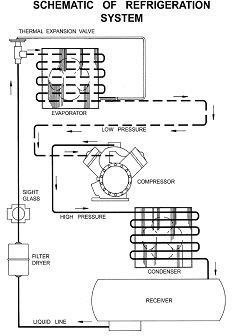Refrigeration System Parts: Vapor Compression Refrigeration Explained
Introduction
We have been studying about various types of marine systems used on board a ship including the propulsion systems which cover the main propulsion plant, marine diesel engines and the various subsystems which assist in smooth running of the vessels such as the steering gear system, electrical system and so forth. Similarly there is another important system on a ship which is necessary for the survival of human beings on board and this is the refrigeration system. We will learn about refrigeration system parts in this articles
Food needs to be stored in bulk quantities on board the ship since a ship may have long voyages. We know that a fresh water generator can be used to convert sea water to fresh water but unfortunately this cannot be said about food. Of course in case of emergencies, you might think of catching fish and eating them but just imagine the case of huge cruise liners and the thousands of passengers on board. Moreover the accommodation spaces need to be maintained at correct temperatures hence the principles of refrigeration are applied for air conditioning and heating purposes. So basically you must have understood the importance of having cold storage spaces on ships which are powered by the refrigeration systems on board.
We will learn about the refrigeration system in detail and start with the basics of refrigeration in this article, so here you go.
Refrigeration is the process of removal of heat from objects and/or spaces in order to maintain them at the temperature lower than the ambient. Refrigeration is carried out in two ways namely;
1. Vapor Absorption Refrigeration.
2. Vapor Compression Refrigeration**.**
Vapor Compression Refrigeration is being universally used for almost all the applications of refrigeration. A gas, also called Refrigerant, is generally used as the medium for heat transfer and, is alternately condensed and evaporated at lower temperatures to remove the heat from the spaces being cooled (refrigerated).
Refrigeration System
The system consists of four processes namely;
1. Compression of refrigerant gas is carried out in a Compressor, which delivers the gas at higher pressure and temperature.
2. The compressed high temperature gas from the compressor is then condensed to high-pressure liquid at ambient temperature in a Condenser.
3. The high-pressure refrigerant liquid is then passed through an Expansion Valve to reduce its pressure. During the process of expansion while passing through the Expansion Valve, the refrigerant liquid gets cooled due to its expansion, rejecting its heat to itself resulting in evaporation of a small part of Refrigerant to vapor. After passing through the Expansion Valve, the Refrigerant consists of mainly low temperature liquid and a small quantity of vapor both at low pressure.
- The liquid Refrigerant containing small quantity of vapor is then passed through the Evaporator coils located in the spaces to be maintained at temperatures lower than the ambient. Here, absorbing heat for its evaporation from the spaces and the objects in the spaces evaporates the Refrigerant gets evaporated.
The low pressure Refrigerant gas leaving the Evaporator coils returns back to Compressor and thus the cycle is repeated again.
Application of Refrigeration Systems
1. Storage of food stuffs at low temperatures to prevent them from rotting and increase their shelf life i.e. Domestic Refrigerators, Cold Storages, Refrigerated Containers and Vans for food transportation etc.
2. Air Conditioning of spaces for human comfort i.e. Window Air Conditioners, Central Air Conditioning etc.
3. Industrial Process Cooling.
Main Components of Refrigeration
- Compressors: Several types of compressor are in use for different applications and for different refrigerants i.e. Reciprocating compressors and Rotary Compressors like Screw Compressors, Rotating Vane Compressors and Centrifugal Compressors etc.
- Condensers: Generally Shell and tube type Condensers are used for all applications. They may be either Air-cooled or Water-cooled.
- Expansion Valves: Thermostatic Expansion Valves are used invariably in most of the applications.
- Evaporator Coils: They are generally custom-made as per requirements and may be used along with forced draft fans for better heat transfer.
